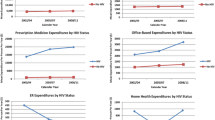Abstract
Each year, the US AIDS drug assistance program (ADAP) provides access to prescription drugs—including antiretrovirals—to more than 110,000 persons living with HIV (PLWH) who lack adequate medical insurance. PLWH on effective antiretroviral therapy live longer lives, with enhanced quality of life, and are less likely to transmit HIV to others. There are thus significant benefits associated with the ADAP program. But there also are substantial costs. A mathematical model was used to assess the cost-effectiveness of the US ADAP program. Findings indicate that by providing antiretrovirals to underinsured persons, the ADAP program prevented 3,191 secondary infections and saved 24,922 quality-adjusted life years in 2008. The net cost per quality-adjusted life year saved was $11,955, which suggests that the ADAP program is cost-effective by conventional standards.
Similar content being viewed by others
References
Kates J, Penner MC, Crutsinger-Perry B, Leggoe AW, Singleton N. National ADAP monitoring project: annual report. The Henry J. Kaiser Family Foundation (KFF) and The National Alliance of State and Territorial AIDS Directors (NASTAD) (2005).
Carbaugh AL, Kates J, Crutsinger-Perry B, Ginsburg B, Penner MC. National ADAP monitoring project: annual report. The Henry J. Kaiser Family Foundation (KFF) and The National Alliance of State and Territorial AIDS Directors (NASTAD) (2009).
Kaiser Family Foundation. AIDS drug assistance programs (ADAPs). 2009 Fact Sheet #1584. Accessed 2 July 2011 http://www.kff.org/hivaids/upload/1584_10.pdf.
Johri M, Paltiel D, Goldie SJ, Freedberg KA. State AIDS drug assistance programs: equity and efficiency in an era of rapidly changing treatment standards. Med Care. 2002;40:429–41.
Chen LF, Hoy J, Lewin SR. Ten years of highly active antiretroviral therapy for HIV infection Med J Aust. 2007;186:146–51.
The Strategies for Management of Antiretroviral Therapy (SMART) Study Group. CD4+ count-guided interruption of antiretroviral treatment. NEJM. 2006;355:2283–96.
Burman, WJ, Grund B, Roediger MP, Friedland G, Darbyshire J, Wu AW, for the SMART Study Group. The impact of episodic CD4 cell count–guided antiretroviral therapy on quality of life. J Acquir Immune Defic Synd 2008;47:185–193.
Attia S, Egger M, Muller M, Zwahlen M, Low N. Sexual transmission of HIV according to viral load and antiretroviral therapy: systematic review and meta-analysis. AIDS. 2009;23:1397–404.
De Cock KM, Crowley SP, Lo Y-R, Granich RM, Williams BG. Preventing HIV transmission with antiretrovirals. Bull World Health Organ. 2009;87:488–9.
Pinkerton SD. HIV transmission rate modeling: a primer, review, and extension. AIDS Behav. 2011;16(4):791–6. doi:10.1007/s10461-011-0042-8.
Schackman BR, Gebo KA, Walensky RP, Losina F, Muccio T, et al. The lifetime cost of current human immunodeficiency virus care in the United States. Med Care. 2006;44:990–7.
Farnham PG, Sansom SL, Hutchinson AB. How much should we pay for a new HIV diagnosis? A mathematical model of HIV screening in US clinical settings. Med Decis Making 2012; 32(3):459–69. http://mdm.sagepub.com/content/early/2012/01/03/0272989X11431609.full.pdf.
Tengs TO, Lin TH. A meta-analysis of utility estimates for HIV/AIDS. Med Decis Making. 2002;22:475–81.
Mannheimer SB, Matts J, Telzak E, Chesney M, Child C, Wu AW, et al. Quality of life in HIV-infected individuals receiving antiretroviral therapy is related to adherence. AIDS Care. 2005;17:10–22.
Centers for Disease Control and Prevention. Vital signs: HIV prevention through care and treatment, United States. MMWR. 2011;60:1618–23.
Cohen MS, Chen YQ, McCauley M, Gamble T, Hosseinipour MC, Kumarasamy N, et al. Prevention of HIV-1 infection with early antiretroviral therapy. NEJM. 2011;365:493–505.
Marks G, Crepaz N, Janssen RS. Estimating sexual transmission of HIV from persons aware and unaware that they are infected with the virus in the USA. AIDS. 2006;20:1447–50.
Quinn TC, Wawer MJ, Sewankambo N, Serwadda D, Li C, Wabwire-Mangen F, et al. Viral load and heterosexual transmission of human immunodeficiency virus type 1. NEJM. 2000;342:921–9.
Laufer FN. Thresholds in cost-effectiveness analysis—more of the story. Value in Health. 2005;8:86–7.
Laupacis A, Feeny D, Detsky AS, Tugwell PX. How attractive does a new technology have to be to warrant adoption and utilization? Tentative guidelines for using clinical and economic evaluations. CMAJ. 1992;146:473–81.
Schrappe M, Lauterbach K. Systematic review on the cost-effectiveness of public health interventions for HIV prevention in industrialized countries. AIDS 1998;12 (suppl A):S231–S238.
Tengs TO, Adams ME, Pliskin JS, Safran DG, Siegel JE, Weinstein MC, et al. Five-hundred life-saving interventions and their cost-effectiveness. Risk Anal. 1995;15:369–90.
Prejean J, Song R, Hermandez A, Ziebell R, Green T, Walker F, et al. Estimated HIV incidence in the United States, 2006–2009. PLoS ONE. 2011;6:e17502. doi:10.1371/journal.pone.0017502.
Kaiser Family Foundation. AIDS drug assistance programs (ADAPs) with waiting lists or other cost-containment strategies, as of May 2011. Accessed 15 June 2011http://www.statehealthfacts.org/comparemaptable.jsp?ind=552&cat:11&sub=204&yr=1&typ=5.
Centers for Disease Control and Prevention. HIV surveillance—United States, 1981–2008. MMWR. 2011;60:689–93.
Pinkerton SD. How many sexually-acquired HIV infections in the US are due to acute-phase HIV transmission? AIDS. 2007;21:1625–9.
Acknowledgments
This study was supported by center grant P30-MH52776 from the National Institute of Mental Health (NIMH), by NIMH grant R01-MH077511, and by a grant from the Robert Wood Johnson Foundation.
Author information
Authors and Affiliations
Corresponding author
Rights and permissions
About this article
Cite this article
Pinkerton, S.D., Kibicho, J. & Galletly, C.L. Is the US AIDS Drug Assistance Program Cost-effective?. AIDS Behav 17, 1–4 (2013). https://doi.org/10.1007/s10461-012-0321-z
Published:
Issue Date:
DOI: https://doi.org/10.1007/s10461-012-0321-z




